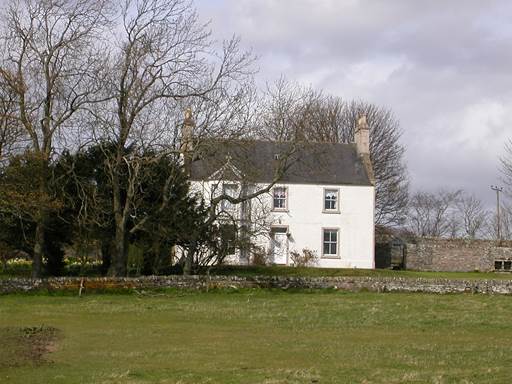Strachan of Carmyllie
Strachan of Carmyllie
By Jim Strachan, MBA (7 August
2022)
Clan Strachan Scottish Heritage Society, Inc.
All photographs are copyright by their original holders.

Figure 1: House stands on the site of what we believe is Carmyllie Castle
Carmyllie is located north and slightly east of Panmure in Angus:

Figure 2:
Forth of Tay, Angus
Also NLS, Forfarshire, Sheet XLV, OS Six-inch 1st edition,
1843-1882 (click
here)
The noble family 'de Strachan' supported the Balliol and Comyn cause, and opposed Robert the Bruce. At the Battle of Inverurie in 1308, forces loyal to the Bruce triumphed over the Comyns and their allies, killing them or driving them into exile.
On 23 and 24 June 1314, at the Battle of Bannockburn, after the first day of battle, Sir Alexander Seton defected from the English and met with Robert de Bruce, urging him to fight the next day as the English troops were demoralised. It is doubtful Seton was a lone defector and almost certainly was accompanied by close followers.
Charters confirm that the Strachan family did not flee to England with the rest of the disinherited. Subsequently, it is almost certain the 'de Strachan' family accompanied Seton (likely their cousin) when he defected at Bannockburn.
On 1 November 1315, King Robert I (The Bruce) disinherited the 'de Strachans', granting the barony of Strachan to Sir Alexander Fraser, his future brother-in-law, and future Great Chamberlain of Scotland.
Grant of Carmyllie
Although arguably not the most prominent, the Strachans of Carmyllie were the senior House of Strachan after the 1315 disinheritance, having been the first to be erected in about 1324.
Between c 1324x8, near the end of King Robert I's reign, the Strachan family reconciled with the king. Henry of Maule, Lord of Panmure, granted to Alexander, son and heir of John, younger of Strachan, and Christina, his daughter, lands of Carmyllie and other lands in Angus (PR, ii, 158-9; and RRS, vi, no. 106.).
We must recall that in order of precedence, blood and interconnection through marriage were the most important social relationships during the Medieval period. Subordinate to this were bonds formed through neighbouring landowners. Moreover, marriages, particularly among the nobility, were political.
Why then would Henry Maul, baron of Panmure, allow his daughter to marry into a family whose lands had been disinherited by the Crown? Moreover, why would Henry risk raising the ire of King Robert de Bruce by making such a grant to a traitorous family? It seems evident that the Strachan family reconciled with King Robert near the end of his reign. This likely occurred after 1324 when Pope John XXII declared Robert de Bruce the rightful monarch of an independent Scotland.
There are several possibilities regarding political or family connections that may have brokered a reconciliation with King Robert.
The barony of Panbride is adjacent to the barony of Panmure, and Panbride was held by the Malherbe family, Lords of Morham. In the book, House and Barony of Strachan, it suggests at least a moderate probability the Strachan family were a cadet line of the Lords of Morham.
Moreover, the Strachan family were likely tenants of Arbroath Abbey and resided at Monboddo Castle. It may be the abbots of Arbroath brokered a peace.
However, what seems more likely is that the reconciliation may have been brokered from within King Robert's household. The Strachan family were almost certainly cousins of Sir Alexander Seton. In 1309, John de Strachan was in the service of Sir Alexander Seton and granted the knight a charter of donation while at Perth, which was an English garrison town and supply base. It has been proposed that the Strachan family accompanied Sir Alexander Seton when he defected from the English at Bannockburn to join the Scots. Given John's prior loyal patronage, there is a moderate to high probability that John Strachan's son and heir, Alexander Strachan, may have been named after of Sir Alexander Seton. Interestingly, Alexander Seton, knight, was serving in the Carrick household of Prince David (b. 1324). It is uncertain if the Strachans were still followers of Seton. However, the possibility exists that Seton may have brokered a reconciliation on behalf of his cousins.
Demise of the House of Carmyllie
In March 1593, a contract of marriage was entered between Patrick Maule, younger of Panmure, Margaret Erskine, his spouse, and Elizabeth Maule, their daughter, on one part, and James Strachan of Carmyllie (eldest son of David) on the other; for the marriage of the said James and Elizabeth (Reg. of Deeds, vol. lxxxi).
With no heirs-male, it is believed that upon the death of James Strachan of Carmyllie, the lands held by the Strachan family for approximately 300 years hence passed back to his wife and therefore to the same family who originally granted the lands of Carmyllie to the Strachans in about 1325.

Figure
3: Arms of Thomas Strachan of Carmyllie (c 1547)
Stevenson & Wood. Scottish Heraldic Seals, iii, 623
Cadet Lines:
Strachan of Brigtoun, Strachan of Claypotts (Claypotts Castle is located in Broughty Ferry), Strachan of Skethin (Skeichen in the barony of Panmure)